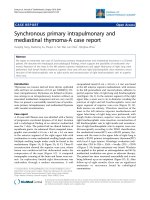Báo cáo y học: "Manifestations of Ollier’s disease in a 21-year-old man: a case report" pdf
Bạn đang xem bản rút gọn của tài liệu. Xem và tải ngay bản đầy đủ của tài liệu tại đây (1.15 MB, 3 trang )
Case report
Open Access
Manifestations of Ollier’s disease in a 21-year-old man: a case report
Babak Fallahi
1
, Morteza Bostani
1
, Kianoush Ansari Gilani
1
, Davood Beiki
1
and Ali Gholamrezanezhad
2
*
Address:
1
Research Institute for Nuclear Medicine, Tehran University of Medical Sciences, Shariati Hospital, Northern Kargar Street, Tehran, Iran
and
2
Young Researchers Club, Azad Medical Unit, Gholhak, Zargandeh, Tehran, Iran
Email: AG -
* Corresponding author
Published: 28 May 2009 Received: 7 January 2009
Accepted: 22 January 2009
Journal of Medical Case Reports 2009, 3:7759 doi: 10.1186/1752-1947-3-7759
This article is available from: />© 2009 Fallahi et al; licensee Cases Network Ltd.
This is an Open Access article distributed under the terms of the Creative Commons Attribution License (
/>which permits unrestricted use, distribution, and reproduction in any medium, provided the original work is properly cited.
Abstract
Introduction: Olli er’ s disease is a rare nonhereditary disorder characterized by multiple
enchondromas with a predilection for unilateral distribution. Malignant changes in Ollier’s disease
may occur in adult patients. Radionuclide bone scanning is one method used to assess lesions
depicted on radiographs or magnetic resonance images that are presumed to be enchondromas. Also,
a bone scan may give a clue to the multifocal nature of the disease and it has been recommended
that scintigraphy is useful in the monitoring of lesions and the development of any malignant
transformation.
Case presentation: A 21-year-old man with a history of pathologic fractures of the right tibia and
multi ple limb surgeri es related to Ollier’s disease was referred to our nuclear medicine department.
Radio graphic assessment showed multiple radiolucent expansile lesions, suggestive of multiple
enchondroma s. A whole-body bone (
99m
Tc-MDP) scan showed multiple foci of increased activity
involving the proximal and distal right fem ur and tibia, proximal right humerus, distal right u lna,
right metacarpals, metatarsals and phalyngeal tubular bones, consistent with unilateral distribution
of the lesions. T he long bones of the left hemi-skeleton were unremarkable, representing unilatera l
involvement of the skeleton. In this case, the intensity of uptake in the lesions of the lower
extremity was high, raising the possibility of malignant degeneration of the enchondromas. Hence,
the patient underwent surgical ex cision of the suspected lesions. Pathology analysis revealed thei r
benign natur e.
Conclusion: Although the malignant transformation of enchondromas is a well k nown
phenomenon, it should be kept in mind that other etiologies can be considered as the cause of
intensely increased uptake. Retrospective assessment of our patient revealed that the etiology of
increased uptake in the lower limb lesions was due to previous insufficiency fractures and the
possibility of malignant transformation was ruled out based on the pathology findings.
Page 1 of 3
(page number not for citation purposes)
Introduction
Ollier’s disease, a rare nonhereditary disorder character-
ized by multiple enchondromas with a predilection for
unilateral distribution [1], was initially described by Ollier
in 1899 [2]. The characteristic features of the disease are
created by persisting cartilage masses in the metaphyses
and diaphyses, which are formed by subperiosteal
deposition of cartilage [2]. In fact, echondromas tend to
occupy the diaphyseal region in the short tubular bones
and the metaphyseal region in the long bones [1]. The
pattern of limb involvement is usually asymmetrical, with
one side being exclusively or predominantly involved [2].
The disease is usually detected during early childhood [3].
Notable clinical problems are progressive shortening of
the involved extremity, angular deformity, pathological
fractures and malignant transformation in 20% to 50% of
cases [2,3]. There may be some gait problems caused by
limb-length discrepancy, as lesions frequently involve the
femur or tibia [2]. Malignant changes in Ollier’s disease
may occur in adult patients [2]. As dysplasia progresses,
there is an increased probability of malignant transforma-
tion into chondrosarcoma [4]. Synchronous multicentric
chondrosarcomas arising from Ollier’s disease have also
been previously reported [4]. The treatment involves
correction of angular deformities and limb-lengthening
procedures [2].
Radionuclide bone scanning is one method used to assess
lesions depicted on radiographs or magnetic resonance
images that are presumed to be enchondromas [2]. Also, a
bone scan may give a clue to the multifocal nature of the
disease.
Case presentation
A 21-year-old man presented with a history of pathologi-
cal fractures of the right tibia and multiple incidences of
limb surgery related to this rare dysplasia. Radiography
assessment showed multiple radiolucent, expansile,
homogenous lesions with an oval or elongated shape
and well defined, slightly thickened bony margins,
suggestive of multiple enchondromas (Figures 1 and 2).
There was no cortical erosion, extension of the tumor into
soft tissues or irregularity or indistinctness of the surface of
the tumor.
A whole-body bone scan obtained 3 hours after intrave-
nous injection of 20 mCi (740 MBq)
99m
Tc-MDP showed
multiple foci of increased activity involving the proximal
and distal right femur and tibia, proximal right humerus,
distal right ul na, right metacarpals, metatarsals and
phalyngeal tubular bones, consistent with a unilateral
distribution of the lesions (Figure 3). There were no
deformities of the affected limbs. The long bones of the left
hemi-skeleton were unremarkable, representing unilateral
involvement of the skeleton.
In this case, the intensity of uptake in lesions of the lower
extremity was so high that the possibility of malignant
degeneration of the enchondromas was raised [4]. Hence,
the patient underwent surgical excision of the suspected
lesions. Pathology analysis revealed their benign nature.
Discussion
Chondromas are benign tumors of hyaline cartilage. They
may arise within the medullary cavity, where they are
known as enchondromas. In fact, enchondromas are the
Figure 1. Bone lesions in the small bones of the right hand
consistent with multiple enchondromas.
Figure 2. Bone lesions in the small bones of the right foot
consistent with multiple enchondromas.
Page 2 of 3
(page number not for citation purposes)
Journal of Medical Case Reports 2009, 3:7759 />most common cause of intraosseous cartilage tumors.
They are most frequent from the 20th to the 40th year of
age. The cartilage tumors in enchondromatosis are
asymptomatic and are detected as incidental findings.
However, the cartilage tumors in enchondromatosis may
be numerous and large, producing severe deformities. The
radiography features are characteristic, as the unminer-
alized nodules of the cartilage produce well-circumscribed
oval lucencies that are surrounded by a thin rim of
radiodense bone (O-ring sign). If the matrix calcifies, it is
detected as irregular opacities.
It has been emphasized that Ollier’s disease usually stops
spontaneously with skeletal maturity; therefore, any lesion
showing activity or increased uptake after termination of
the growth period requires thorough examination [2,5].
Scintigraphy has been recommended as useful in the
monitoring of lesions and of the development of any
malignant transformation [5]. Although the malignant
transformation of enchondromas is a well-known phe-
nomenon, it should be kept in mind that other etiologies
can be considered as the cause of intensely increased
uptake.
As was mentioned by Silve and Juppner, the histopatho-
logical criteria for malignancy, which are used for
conventional chondrosarcomas, cannot be applied for
Ollier’s disease because of the increased cellularity;
hence, distinguishing enchondromas from grade-I
chondrosarcomas in the context of enchondromatosis is
extremely difficult or even impossible [6]. The diagnosis
therefore is based on the combination of radiological,
clinical and histological criteria [6]. In our case, as there
was no cortical destruction or soft tissue extension, the
histopathological diagnosis of benign lesions was reliable.
Retrospective assessment of our patient revealed that the
etiology of increased uptake in the lower limb lesions was
due to previous insufficiency fractures and the possibility
of malignant transformation was ruled out based on the
pathology findings.
Conclusion
Although the malignant transformation of enchondromas
is a well known phenomenon, it should be kept in mind
that other etiologies should also be considered as the cause
of intensely increased uptake.
Consent
Written informed consent was obtained from the patient
for publication of this case report and any accompanying
images. A copy of the written consent is available for
review by the Editor-in-Chief of this journal.
Competing interests
The authors declare that they have no competing interests.
Author’s contributions
BF revised the article for intellectual content details and
helped to draft the manuscript. AG participated in writing
of the manuscript and interpretation of the scintigraphic
figures. KA, MB and DB supervised the acquisition process
and interpreted the scintigraphic and radiological images.
All authors read and approved the final manuscript.
Acknowledgements
We are indebted to the technologists at our department for
data acquisition and other technical support.
References
1. Kaya H, Komek H, Cerci SS, Tuzcu SA: Bilateral symmetrical
Ollier disease and Tc-99m MDP bone scintigraphy. Clin Nucl
Med 2004, 29(7):456.
2. Trikha V, Gupta V: Ollier’s disease characteristic Tc-99m-MDP
scans features. Clin Nucl Med 2003, 28:56-57.
3. Pannier S, Legeai-Mallet L: Hereditary multiple exostoses and
enchondromatosis. Best Pract Res Clin Rheumatol 2008, 22:45-54.
4. Nguyen BD: Ollier disease with synchronous multicentric
chondrosarcomas: scintigraphic and radiologic demonstra-
tion. Clin Nucl Med 2004, 29(1):45-47.
5. Schwartz HS, Zimmerman NB, Simon MA, Wroble RR, Millar EA,
Bonfiglio M: The malignant potential of enchondromatosis.
J Bone Joint Surg 1987, 69:269.
6. Silve C, Juppner H: Ollier disease. Orphanet J Rare Dis 2006, 1:37.
Figure 3. Bone scan of the same patient showing areas of
radiotracer uptake in the humerus, ulna, femur, tibia,
metacarpal, metatarsal and phalyngeal tubular bones,
all located asymmetrically in the right side of the body.
Page 3 of 3
(page number not for citation purposes)
Journal of Medical Case Reports 2009, 3:7759 />









